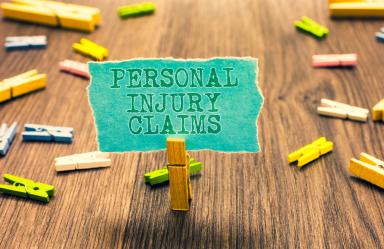How Much Can You Sue for Pain and Suffering? [2024]

In an injury case, it is entirely reasonable for you to seek compensation for financial expenses that you had to pay out of your own pocket as well as losses that you incurred due to another party’s negligence. In legal-speak, the monetary awards that an injured person seeks to recover in a legal case are referred to as “damages” and are categorized in two ways.
The first, called economic damages, are the kinds of measurable losses just described and include such things as medical bills, lost wages, and the costs associated with repairing damaged property. Economic damages can be easily determined as they often involve expenses that you can prove with physical receipts or bills.
However, in this article, we will be focusing on the second category referred to as non-economic damages. These are defined as subjective or non-measurable losses and although they have the highest potential for monetary compensation, they are also the hardest to prove. Follow along as we take a look at these types of damages, how courts calculate them, and how you can best ensure that you and your lawyer are seeking the correct settlement amount for your pain and suffering.
Common Types of Pain and Suffering Damages
There are many types of pain & suffering that can be explored in litigation cases. Recovery from an injury is so much more than just the injury itself. There is also the disruption to your relationships, the changes in your lifestyle, and the pain, physical and mental. Below, we will explore the various types of pain and suffering and how the court defines them.
Physical Pain
Physical pain involves the body’s nervous system sending a distress signal to the
brain that something is wrong. Depending on the injury or accident, it can cover a
wide spectrum of unpleasant experiences. Pain can range from mild temporary discomfort
to severe life-long chronic distress to the agony only associated with the loss
of a limb, spinal injury, traumatic brain injury or a wrongful death. If you are
experiencing pain and discomfort resulting from any kind of injury or accident
due to the negligence of another, you will want to pursue monetary compensation for non-economic damages of this type in your claim or lawsuit.
Mental Anguish and Emotional Distress
Mental anguish can be described as a wide range of emotional suffering categorized by conditions such as distress, torment, fright, anxiety, grief, humiliation, or depression. In order to successfully make a claim for and to receive compensation for this category of damages, the distress or anguish must be proven in court to flow from the accident or injury directly impacting the emotional state of the victim. Mental anguish and emotional distress are often used interchangeably to describe the claims within this category.
To receive an award of monetary damages for such emotional pain, the injured party will need to successfully convince the judge, jury or insurance carrier that the victim’s complaints of mental anguish are legitimate. Yet, this is far from an easy task, because just like physical pain, emotional distress is not something that can be seen on an X-ray, MRI or CT scan. Anyone can say that they hurt, so not surprisingly, courts and insurance carriers are often suspicious.
It usually takes an experienced injury attorney to convince them that complaints of pain are genuine. This task is sometimes both art and science. Well-documented evidence of the plaintiff’s emotional or mental state can be demonstrated in many ways, including proof of new medications, documented visits with medical or psychiatric professionals, “day-in-the-life videos” (documenting the plaintiff’s daily struggles) and testimony from others such as expert witnesses and family members.
Loss of Enjoyment or Diminished Quality of Life
If your ability to enjoy or engage in life has decreased following an injury or accident, you may seek monetary compensation related to this category of non-economic damages. Regardless of the nature or extent of the injury, different people are affected in different ways. It does not have to be a life-long catastrophic injury for someone to experience diminished satisfaction or quality of life post-injury. Some people enjoy working out at the gym each day or are big hikers or golfers. When an accident affects their ability to take part in valued activities, life can change dramatically. Head injuries may cause extreme changes to their behavior and moods. People who were once the “life of the party” may become withdrawn. Their ability to keep up at work may be reduced or eliminated. This category of damages is intended to compensate the injured party for these losses.
Permanent Disfigurement or Disability
A permanent injury can significantly alter the way a person lives their life and their self-worth. Monetary compensation for damages such as these is appropriate when an injury leaves a person physically changed or unable to perform daily activities as they once did. Amputations, scars, blindness, hearing loss, facial disfigurement and inability to bear children are just some examples of these injuries. People who once were independent and able to drive a car independently may now need to rely on family or depend upon expensive caregivers. This category of damages is intended to provide compensation for these harmful consequences.
Loss of Companionship or Consortium
Loss of companionship (also known as a loss of consortium) is defined as the loss or impairment of the non-monetary benefits in a marriage. A spouse provides companionship, love, and affection but even further, consortium includes shared housework, activities, and their sexual relationship. The loss of any of these benefits would be included under this category of damages. In most states, this category is restricted to married couples, meaning that unwed couples may not always be able to pursue damages no matter the length of their relationship. In some states, the loss of consortium can also be used for parents who have lost a child in a wrongful death or fatal injury.
Factors That Influence Personal Injury Settlement and Jury Verdict Amounts
Settlement amounts negotiated with insurance companies and dollar amounts awarded after a successful trial verdict vary significantly across all injury categories. If you looked at the amounts received by 10 different people who each broke their left arm in 10 different car accidents, you would be likely to find that no two received the same amount of monetary compensation. That’s because no two cases are ever exactly the same. Dozens of factors will influence the final result, including such things as the specific injuries involved, their future prognosis for full recovery, their age / health, their need for future treatment, the court location, and the experience of the attorneys involved. The section below will explore the factors that can influence a personal injury settlement.
Extent of Injury
By far, probably the most important factor that will influence the final monetary amount received is the extent and severity of the injury. As you might expect, lower settlement amounts are usually seen in cases where the injury was minor, and recovery was quick with few medical bills or doctor visits. The more severe the injury, the higher the settlement is likely to be. This is due to a number of factors, including the cost of medical care, permanent lifestyle changes, potential complications, as well as the pain and suffering experienced by the victim.
Medical Care
Another important factor that directly influences monetary settlements on injury cases is the extent of medical care required by the injured party, including all past medical expenses and projected future care. The nature and quality of the medical care is also of great importance. For instance, a settlement amount would be expected to be much higher for an injury involving an emergency surgery than that for a “soft-tissue” injury requiring a year’s worth of chiropractic appointments. The necessity for future treatment, future surgeries or personal home healthcare will also greatly affect an injury settlement.
Defendant’s Insurance
In most personal injury cases, the claimant will first attempt to negotiate with the defendant’s insurance company before actually filing a lawsuit, although this is not always the case for various strategic reasons or in cases when the Statute of Limitations (deadline to file before your rights expire) is quickly approaching. Insurance policies have restrictions and limitations about certain events that they will refuse to cover. The policy limits (maximum amount that they are obligated to pay out) are quite low for some policies and very high (in excess of a million dollars) for others. Also, some insurance companies are simply difficult to work with and often refuse to settle without first being sued in court. All these factors influence a final settlement. If a case cannot be settled and a trial occurs however, most states prohibit the jury from hearing whether the defendant is insured and what the policy limits are.
Proving Liability or Negligence
Generally, negligence means that the other party acted in a way which was careless or unreasonable considering the specific circumstances and this caused harm to the victim. Negligence can also mean that the other failed to do something which caused harm and that this inaction was unreasonable. In most injury cases, there can be no monetary recovery or settlement without first demonstrating the negligence of the other responsible party. If a settlement is being negotiated, but the insurance company cannot be convinced that their defendant was negligent, it is unlikely that they will be willing to offer any compensation. Similarly, if a case goes to trial but the plaintiff cannot convince the jury of the defendant’s negligence, the defendant cannot win. For these reasons, proving negligence is of the greatest importance in any injury or medical malpractice case.
Comparative Negligence
In determining fault, states generally operate under the laws of comparative negligence or contributory fault. This means that when considering who was at fault, a percentage of the fault will be assigned by the court to both parties.
Most states use what is called a “Modified Contributory Negligence” rule which means that depending on the amount of fault the claimant is assigned, it will reduce the damages awarded by that percentage. If the claimant is found to be more than 50% or 51% at fault, they will not be awarded any damages at all though. So, if the person who filed the claim was found to be 40% at fault for the accident and the damages were found to be $100,000, they would receive only $60,000 due to their damages being reduced by 40%.
Some other states follow a “Pure Comparative Negligence” rule which means that even if the claimant is 99% at fault, they can still collect 1% of the damages. On the far other end of the spectrum though are a handful of states that use a “Pure Contributory Negligence” rule which means that if the plaintiff is even 1% at fault, they cannot collect damages.
How is Pain and Suffering Calculated?
It is important to keep good records so that later you can provide clear and accurate documentation of your injuries to ensure that you are properly compensated for your pain and suffering damages. Medical bills, treatment records, photos of the injury, medical bills, list of medications, and psychiatric evaluations can all be used as evidence to support the claim. An experienced attorney will also often use additional tools such as hiring an expert medical witness or creating a “day in the life” video which demonstrates the victim’s daily struggles. Proving these non-economic damages and then converting them into a dollar amount requires both strategy and skill. It is ultimately up to the claimant and their legal team to prove the validity of these damages, while it is in the best interest of the opposing party to minimize these damages.
The Pain Multiplier
Insurance companies often use what is called a “Pain and Suffering Multiplier” in determining what a fair settlement might be for these non-economic damages. The method attempts to determine pain and suffering by taking the total sum of economic damages (medical expenses, lost wages, etc.) and multiplying it by a set number known as “the multiplier.” The multiplier usually ranges from 1.5 to 5+ depending on the severity of the injury with higher numbers intended for severe or fatal injuries.
Although this method of calculating damages can be a useful tool, many knowledgeable attorneys are critical of this method because it can easily lead to misleading and arbitrary results. In many cases, the final number may be far lower than reasonable, because every case is different. For example, damages for a broken nose injury should probably be higher for a person employed as a model than for a construction worker, because it will likely affect the model’s employment to a greater degree. Similarly, damages for family members left behind after the wrongful death of their father/husband cannot simply be calculated as 5 times the deceased’s medical bills.
The Per Diem Approach
The name “per diem” comes from the Latin language and translates to “per day”. So, as the name suggests, this approach seeks to compensate the claimant based on the number of days they experience pain. For example, if the victim was actively experiencing pain for two months (60 days) following a car accident and the court placed the per diem rate at $100, they would receive $6,000 in total damages.
Just like the Pain Multiplier method, many attorneys feel that the per diem approach, although a useful tool, often fails to take into consideration the particular circumstances of the injured party, sometimes leading to unnecessarily low damage numbers. For this reason, it is usually best to consult with an experienced attorney before attempting to negotiate a settlement.
Legal Resources
To ensure you get the highest payout for your claim, consider contacting an attorney to help guide you through your case. Attorneys are experienced in estimating damages and gathering crucial information to prove their validity. An attorney will guide you through the entire litigation process, keeping the process running smoothly and without avoidable setbacks. Linked below are resources for those curious about contacting an attorney or others who might need some extra help navigating a lawsuit.
Expertise.com
We here at Expertise.com utilize an extensive research process to ensure that they are able to bring you the best recommendations in over 200 industries. Expertise combs through each attorney’s qualifications, taking note of their skills, specialties, and successes. Check out the directory to find the top lawyers in your state.
Need Some Extra Assistance?
A few other pages offer extra help to those with language barriers or just need some extra help navigating the justice system for low costs (or free!).
USA.gov aims to make government services easy to access. They offer links to affordable legal help and resources for specific groups, such as the National Disability Rights Network for disabled folks, as well as other links for Seniors and Veterans.
ESL or Legal Translators
If you need an interpreter, you may be able to request one through the court’s interpreter services. Check in with the court to learn whether an interpreter can be ordered ahead of time or whether this assistance will need to be ordered by the judge.. The Immigration Assistance Network has legal resources on its page that aim to ensure that your rights are protected and that you have the right tools to succeed in court.
Expertise.com StaffAuthor
Step into the world of Expertise.com, your go-to hub for credible insights. We don't take accuracy lightly around here. Our squad of expert reviewers, each a maestro in their field, has given the green light to every single article you'll find. From rigorous fact-checking to meticulous evaluations of service providers, we've got it all covered. So feel free to dive in and explore. The information you'll uncover has been stamped with the seal of approval by our top-notch experts.

Mitchell SexnerReviewer
A graduate of Northwestern University and Chicago Kent College of Law, Mitchell Sexner is a former criminal prosecutor and founder of Sexner & Associates LLC, representing clients in multi-million dollar injury and medical malpractice cases. Visit: https://chicagoinjurylawyer.net/




